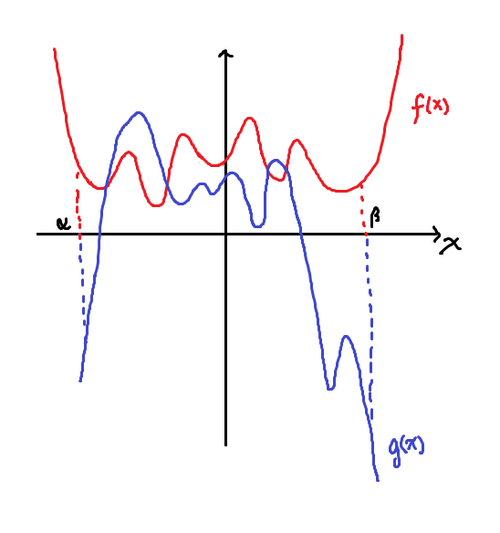Extrapolation
 Observe the graph above. The graphed functions
f
(
x
)
,
g
(
x
)
are both polynomials in
x
with
f
(
x
)
being a degree 10 polynomial.
Observe the graph above. The graphed functions
f
(
x
)
,
g
(
x
)
are both polynomials in
x
with
f
(
x
)
being a degree 10 polynomial.
It is given that f ( x ) is monotonically decreasing in the interval ( − ∞ , α ) and monotonically increasing in the interval ( β , ∞ ) ; g ( x ) is monotonically increasing in the interval ( − ∞ , α ) and monotonically decreasing in the interval ( β , ∞ ) .
With this information, if x f , m , x g , n are the (not necessarily distinct, possibly complex) roots of f ( x ) , g ( x ) respectively, find the maximum possible value of
de g ( f ) ⋅ de g ( g ) ⋅ sgn ⎝ ⎛ m = 1 ∏ de g ( f ) x f , m ⎠ ⎞ ⋅ sgn ⎝ ⎛ n = 1 ∏ de g ( f ) x g , n ⎠ ⎞
where de g ( f ) is the degree of f and sgn ( x ) is the sign function .
The answer is -100.
This section requires Javascript.
You are seeing this because something didn't load right. We suggest you, (a) try
refreshing the page, (b) enabling javascript if it is disabled on your browser and,
finally, (c)
loading the
non-javascript version of this page
. We're sorry about the hassle.
1 solution
I moved this into calculus.
I disagree with your conclusion that "from Lemma 1, we know that de g f = de g g = 1 0 . What we know is that de g f ≥ 1 0 , because some of these could be repeated roots.
Log in to reply
If there happen to be repeated roots, would there not (sometimes) be inflection points with derivative 0? I might be mistaken about this point.
Also, I've changed the answer to "maximum possible value of...".
Log in to reply
Your problem doesn't prohibit having inflection points with derivative 0.
For example, the graphs of y = ( x − α ) 2 ( x − β ) 2 and x − α ) 4 ( x − β ) 4 look the same graphically, and cannot be distinguished by your conditions.
Also, don't you want the maximum? Since the product is always negative.
I did everything the same except the part where you showed the product of roots. The product of signs functions of complex roots has to be 1 since they are complex conjugates of each other and for real roots can be checked from graph
Lemma 1:
The degree of a polynomial f is equal to one more than the number of local extrema. (Include inflection points with tangent 0 as "local extrema".)
If d x d f ( x ) = 0 has n − 1 solutions, it follows that f ( x ) has n − 1 local extrema and degree n .
Lemma 2:
If an even-degree polynomial is "smiling", the product of its roots follows the sign of the y -intercept. If an even-degree polynomial is "frowning", the product of its roots have the reverse sign of the y -intercept.
By Vieta's formulas, ∏ x i = a n a 0 where x i are the roots of the even-degree polynomial. Since an even-degree polynomial is "smiling" when a n > 0 and "frowning" when a n < 0 , the sign of the product depends on a 0 , ie the y -intercept.
Solution:
From Lemma 1, we know that de g ( f ) = de g ( g ) = 1 0 . From Lemma 2, we also know that the sign of the first product is 1 and the sign of the second is − 1 ! Hence, our expression becomes − 1 0 0 .